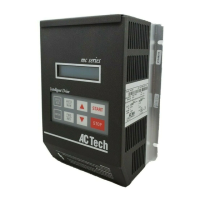15
6.2.1 DRIVE OPERATION
Incoming AC line voltage is converted to a pulsating DC voltage by the input
diode bridge. The DC voltage is supplied to the bus filter capacitors through a
charge circuit which limits inrush current to the capacitors during power-up. The
pulsating DC voltage is filtered by the bus capacitors which reduces the ripple
level. The filtered DC voltage enters the inverter section of the drive, composed of
six output intelligent insulated gate bi-polar transistors (IGBTs) which make up
the three output legs of the drive. Each leg has one intelligent IGBT connected to
the positive bus voltage and one connected to the negative bus voltage. Alternately
switching on each leg, the intelligent IGBT produces an alternating voltage on each
of the corresponding motor windings. By switching each output intelligent IGBT
at a very high frequency (known as the carrier frequency) for varying time intervals,
the inverter is able to produce a smooth, three phase, sinusoidal output current
wave which optimizes motor performance.
6.2.2 CIRCUIT DESCRIPTION
The control section consists of a control board with a 16 bit microprocessor,
keypad and display. Drive programming is accomplished via the keypad or the
serial communications port. During operation the drive can be controlled via the
keypad, by control devices wired to the control terminal strip, or by the serial
communications port. The Power Board contains the control and protection
circuits which govern the six output IGBTs. The Power Board also contains a
charging circuit for the bus filter capacitors, a motor current feedback circuit, a
voltage feedback circuit, and a fault signal circuit. The drive has several built in
protection circuits. These include phase-to-phase and phase-to-ground short
circuit protection, high and low line voltage protection, protection against excessive
ambient temperature, and protection against continuous excessive output current.
Activation of any of these circuits will cause the drive to shut down in a fault
condition.
6.2.3 MC1000 ANALOG INPUT SIGNALS
The drive allows for three speed reference input signals: speed potentiometer
(10,000 Ohm), 4-20 mA, or 0-10 VDC. For control by a speed pot, the wiper lead
is connected to terminal TB-5A, and the high and low end leads are connected to
terminals TB-6 and TB-2, respectively. For 4-20 mA control, wire the positive to
terminal TB-5B and the negative to terminal TB-2. For 0-10 VDC control, wire
the positive to terminal TB-5A and the negative to terminal TB-2. Refer to the
diagrams in Section 15.0 - MC1000 CONTROL WIRING DIAGRAMS.
The input impedance of terminal TB-5A (0-10 VDC input) is 200 kilohms, and
the input impedance of terminal TB-5B (4-20 mA input) is 100 ohms. Terminal
TB-2 is circuit common.

